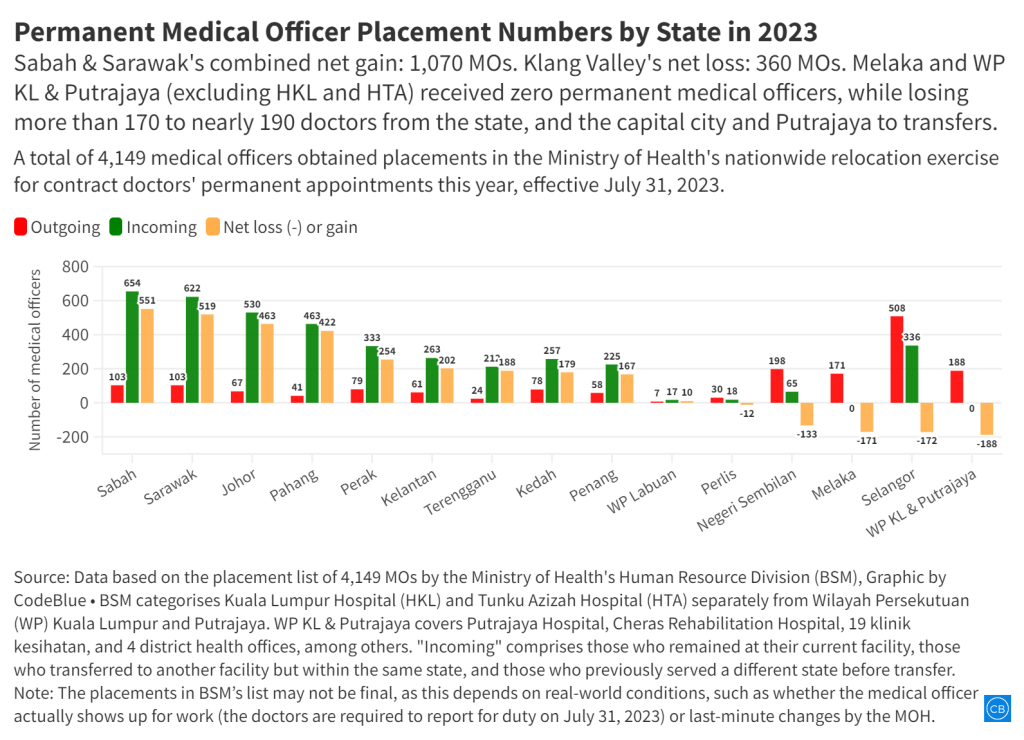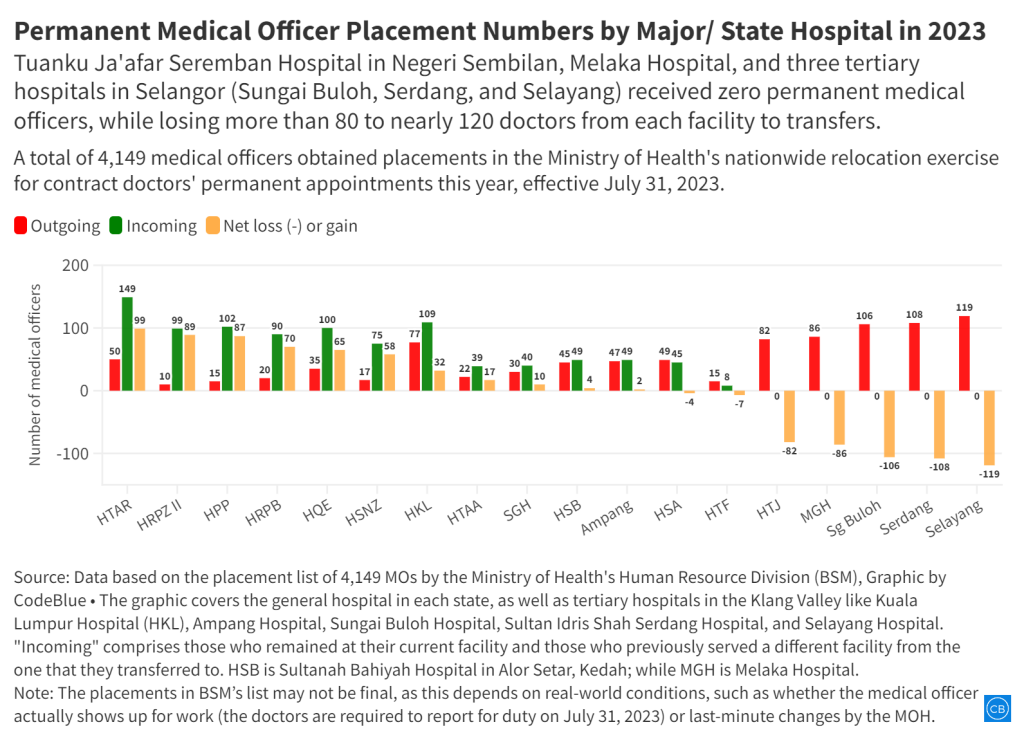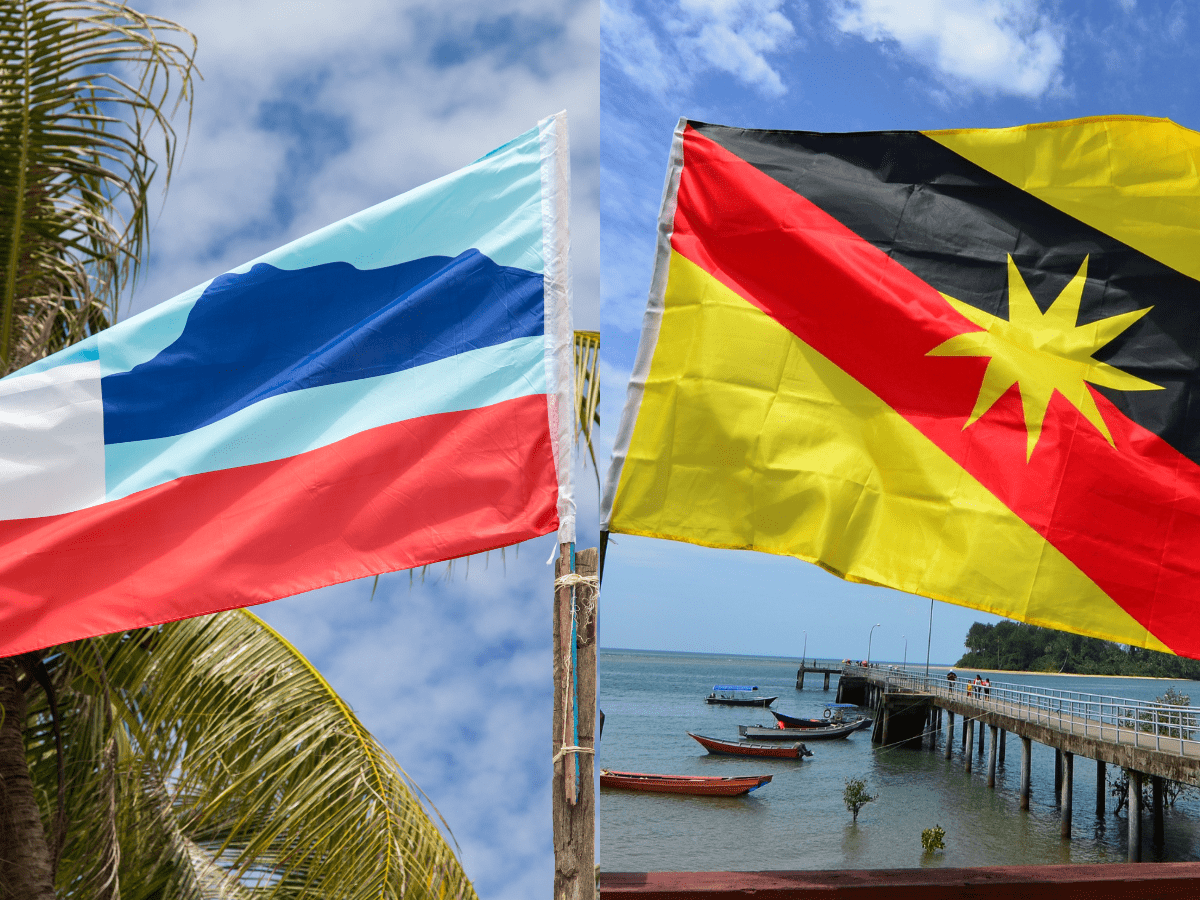KUALA LUMPUR, July 31 – Borneo was the primary beneficiary of the Ministry of Health’s (MOH) nationwide relocation exercise of contract medical officers for permanent positions this year, gaining a whopping net total of 1,070 doctors.
While Sabah and Sarawak each gained net 551 and 519 medical officers respectively — as the permanent appointments took effect today — the Klang Valley suffered a net loss of 360 doctors, threatening to worsen the already critical staffing shortages in the public health care sector in the industrial region.
The relocation exercise hit Wilayah Persekutuan (WP) Kuala Lumpur and Putrajaya the hardest, with a net loss of 188 doctors, according to figures obtained from the MOH’s Human Resource Division’s (BSM) list of 4,149 medical officers who chose placements for permanent positions this year, as sighted by CodeBlue.
Selangor ranked as the second-biggest loser with a net loss of 172 medical officers, closely followed by Melaka (-171) and Negeri Sembilan (-133).
In contrast, Johor and Pahang — the two other main beneficiaries of government doctors’ relocations apart from Borneo — each gained net 463 and 422 medical officers respectively.
BSM classified Kuala Lumpur Hospital (HKL) and Tunku Azizah Hospital (HTA) separately from WP Kuala Lumpur and Putrajaya. Collectively, both HKL and HTA gained net 60 medical officers.
Shockingly, Melaka and WP Kuala Lumpur and Putrajaya (excluding HKL and HTA) received zero medical officers for permanent positions to replace their over 170 to nearly 190 doctors transferring out of the state and the two federal territories.
In Melaka, 171 medical officers relocated out of Melaka Hospital, Alor Gajah Hospital, Jasin Hospital, three district health offices, and the state health department’s public health division to facilities outside Melaka.
In WP Kuala Lumpur and Putrajaya, 188 medical officers transferred out of Putrajaya Hospital, Cheras Rehabilitation Hospital, 19 klinik kesihatan, four district health offices, the WP Kuala Lumpur and Putrajaya health department, and the deputy director’s office at the medical division in the WP Kuala Lumpur and Putrajaya health department to facilities outside the capital city and the country’s administrative centre.
CodeBlue previously reported that the entire state of Melaka was completely omitted from the eHousemen system for medical officers’ placements for permanent appointments, allegedly due to a miscommunication “blunder” between the Melaka state health department and individual health care facilities under the MOH on the number of permanent positions needed in the central state.
The nationwide relocation exercise involved trained medical officers who have already been working in the public health service for at least four to seven years. Medical officers’ latest facilities before placement and facilities for placement in BSM’s list included MOH hospitals, public health clinics, other smaller clinics, and district health offices, among others, throughout Malaysia.
The Respiratory Medicine Institute (IPR) received five medical officers. The National Cancer Institute (IKN) and the disease control division at MOH’s Putrajaya headquarters lost seven and 14 doctors respectively to placements mostly in district hospitals, as well as some klinik kesihatan and district health offices, primarily in Pahang, Sabah, and Sarawak.
BSM categorised IPR, IKN, MOH Putrajaya, HKL, HTA, and two prisons under the Malaysian Prisons Department separately from other state health departments.
The placements in BSM’s list — upon which CodeBlue derived the figures from — may not be final, as this depends on real-world conditions, such as whether the medical officer actually shows up for work (the doctors are required to report for duty today) or last-minute changes by the MOH.
Borneo Gets 31% of Total Permanent Medical Officers who Received Placements

Borneo’s 1,276 doctors comprised about 31 per cent of the total 4,149 medical officers who obtained placements this year for permanent appointments, even though the combined population of Sabah and Sarawak is 18 per cent of Malaysia’s 32.4 million population.
The MOH’s relocation of more than 4,100 medical officers in a bid to optimise health care professional distribution, particularly in Sabah and Sarawak, has sparked serious concerns among doctors, who warned that the move could put patient safety at risk as major hospitals in the Klang Valley, Melaka, and Negeri Sembilan cope with chronic understaffing and staff burnout.
In the past month, CodeBlue ran a series of stories detailing the impact of the massive relocation exercise on major public hospitals in Melaka and the Klang Valley — notably at HKL’s emergency department and Selayang Hospital’s obstetrics & gynaecology (O&G) department — where staff shortages could lead to potential resignations, longer wait times, suboptimal care, and possibly endangering patients’ lives.
While Melaka Hospital has temporarily suspended its iFOBT (immunochemical faecal occult blood test) colorectal cancer screening service and is looking to halve elective surgeries offered, hospitals like HKL and Selayang Hospital are unable to reduce services as these serve as national tertiary referral centres for different diseases.
CodeBlue also reported that some young doctors in their early 30s have resorted to pawning gold and withdrawing from their Amanah Saham Bumiputera (ASB) accounts to fund their relocation from the Klang Valley to Sabah. This is because contract medical, dental, and pharmacy officers taking up permanent positions this year are not eligible to claim for their transfers (tuntutan bertukar pindah), due to a disruption in their period of service from contract to permanent.
Doctor groups like the Malaysian Medical Association and Hartal Doktor Kontrak previously warned the MOH that trained doctors can’t be immediately replaced with “floating” medical officers who just completed their housemanship, as the latter needs additional training of at least three months.
The population of Selangor, Kuala Lumpur, and Putrajaya combined is about nine million, 1.5 times bigger than the combined 5.9 million people across Sabah (3.4 million) and Sarawak (2.4 million).
Even though there is a higher concentration of private hospitals and general practitioner (GP) clinics in the Klang Valley than Borneo, anecdotal reports suggest a rising number of patients switching from private to public health care facilities in recent years.
MOH tertiary hospitals in Selangor also have a much bigger workforce than in Sabah or Sarawak because such centres in Malaysia’s most developed state offer a range of specialised services that cater not only to the region, but also to the entire country.
Public perception that health infrastructure in Borneo is less developed than the peninsula is also not entirely accurate; health infrastructure in Sabah and Sarawak are of diverse levels, similar to West Malaysia, where both dilapidated and advanced public health care facilities can be found throughout the country. Sarawak General Hospital (SGH), for example, has an acute stroke unit running 24 hours a day, seven days a week.
One of the main issues in health care professional distribution for Malaysia’s public health care sector is the balance between population size and geography. The latter is a factor in poor access to health care services in Sabah and Sarawak, while the former requires a large health workforce in the peninsula, particularly in dense urban settings.
Tuanku Ja’afar Seremban Hospital, Melaka Hospital, Sungai Buloh Hospital, Sultan Idris Shah Serdang Hospital, and Selayang Hospital Lose Over 80 to Nearly 120 Medical Officers Each Without Any Replacement

According to BSM data, state hospitals in Melaka and Negeri Sembilan, along with three tertiary hospitals in Selangor (Sungai Buloh, Serdang, and Selayang), did not receive a single doctor in the relocation exercise to replace the more than 80 to nearly 120 medical officers departing from each facility for permanent positions.
This makes these five facilities the biggest losers among general hospitals in each state and tertiary hospitals in the Klang Valley.
Specifically, Selayang Hospital lost 119 medical officers, followed by Sultan Idris Shah Serdang Hospital (-108), Sungai Buloh Hospital (-106), Melaka Hospital (-86), and Tuanku Ja’afar Seremban Hospital [HTJ] (-82).
Melaka’s general hospital and HTJ serve as tertiary referral centres for the entire state of Melaka and Negeri Sembilan respectively. Selayang Hospital is the national tertiary referral centre for hepatology, Sultan Idris Shah Serdang Hospital for cardiology, and Sungai Buloh Hospital for infectious disease.
The absence of any replacement doctors indicates that like the state of Melaka and WP Kuala Lumpur and Putrajaya (excluding HKL and HTA), the five major hospitals were omitted from the eHousemen system for placements for permanent appointments, implemented in five phases between June 9 and June 24. The reasons for their omission may vary and are not completely known.
Tengku Ampuan Rahimah Hospital (HTAR) in Klang was the biggest gainer among state hospitals, with a net gain of 99 medical officers.
Other top gainers included Raja Perempuan Zainab II Hospital (HRPZ II) in Kota Bharu, Kelantan, with a net addition of 89 doctors; Pulau Pinang Hospital [HPP] (87); Raja Permaisuri Bainun Hospital (HRPB) in Ipoh, Perak, with a net gain of 70 doctors; and Queen Elizabeth Hospital (HQE) in Kota Kinabalu, Sabah, with 65 doctors.
It is worth noting that the bulk of incoming doctors into Sabah and Sarawak will be stationed in district or rural health care facilities.
They include areas such as Beaufort, Beluran, Keningau, Kota Marudu, Ranau, Semporna, Sipitang, Tambunan, Tawau, and Tuaran in Sabah; and areas like Bau, Bintulu, Kanowit, Kapit, Limbang, Mukah, Saratok, Sarikei, Serian, Sibu, and Sri Aman in Sarawak.
CodeBlue reported last July 25, quoting a source at HKL, that HKL was expected to see 300 outgoing and 100 incoming medical officers from the relocation exercise, translating to a net loss of 200 doctors.
In the end, according to the final placement list by BSM, the country’s largest MOH hospital lost 77 medical officers but gained 109, leading to a net gain of 32 doctors.
HKL director Dr Rohana Johan and Health Minister Dr Zaliha Mustafa’s office did not respond to CodeBlue’s request for verification of medical officer relocation numbers at HKL, either before or after the HKL story was published.
At a special press conference last Saturday in Kota Bharu, Kelantan, on medical officers’ placements for permanent appointments, Dr Zaliha simply said the MOH approved 332, or 18 per cent, of 1,843 doctors’ appeals.
Following the press conference she held — just two days before the doctors involved in the relocations report for duty today — the health minister tweeted, close to midnight: “To deal with the challenge of doctor shortages in certain hospitals, the MOH will ensure that vacancies are filled as late as December 2023 to ensure smooth health care delivery to the people.”
Dr Zaliha did not elaborate further or specify if services at the affected public hospitals or health clinics would be cut for at least five months or longer, until vacancies are filled and the floating MOs get up to speed. Incidentally, the health minister’s press conference in Kelantan was held on nomination day of six state elections in Selangor, Negeri Sembilan, Penang, Kedah, Kelantan, and Terengganu.








